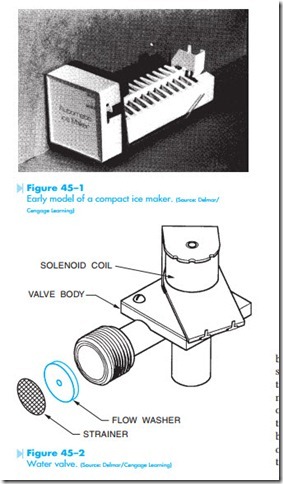Ice makers can be divided into two major categories, household and commercial. Unlike commercial units, household ice makers do not recirculate water. They fill a tray or mold and the water is allowed to freeze. Various methods are used to sense when the water has been frozen and to eject the ice from the tray.
Commercial ice makers generally recirculate the water during the freeze cycle. The one reason for this is that pure water freezes faster than water containing impurities and minerals. The ice formed is more pure and clearer in color. This does not apply to flaker-type machines, however. Flaker or crushed-ice machines use an auger to scrape ice off an evaporator after the water has been frozen.
Some cube-type machines freeze water in the shape of the cube, and others freeze water as a slab. The slab-type machines use a grid of cutter wires to cut the frozen slab into cubes.
HOUSEHOLD ICE MAKERS
One of the most widely used household ice makers is the compact, Figure 45–1. Although a newer model has been introduced, many of these original units are still in operation. The basic operation of this unit is as follows:
1. An electric solenoid valve, Figure 45–2, turns on and fills the tray or mold with water. The valve contains a flow washer that meters
the amount of water. The washer is designed to work with pressures that range between 15 and 100 psi. The length of time the water is permitted to flow is controlled by a cam operated by a small electric motor. The time can be adjusted by moving the water solenoid switch closer to or farther away from the cam. The amount of water needed to fill the mold is approximately 135 cc or 4 oz. It should be noted that insufficient water causes the thermostat to cool too quickly, causing the ice maker to eject hollow cubes.
2. A thermostat senses when the water is frozen. It is mounted directly on the mold by a spring clip. The thermostat controls the start of the ejection and refill cycle.
3. When the thermostat contact closes, it turns on the mold heater and motor. The motor operates the timing cam and ejector blades. The ice maker is so designed that the ejector blades can stall against the ice cubes without causing harm to the motor or mechanical parts. When the heater has warmed the mold sufficiently, the ice cubes are pushed out by the ejector blades.
4. During the ejection cycle, the shutoff arm rises and lowers. The shutoff arm senses the height of ice in the holding bin. If the bin is not full, the arm returns to its original position and the ice maker is permitted to eject ice cubes again after they have been frozen. If the holding bin is full, however, the arm can- not return to its normal position and the next ejection cycle cannot begin. The ice maker can be manually turned off by raising the shutoff arm above its normal range of travel.
The ice maker will normally permit the ejector blades to make two revolutions before the thermo- stat reopens its contact and permits the process to stop at the end of the cycle. If the ejector blades make only one revolution, the ice cubes will be left on top of the blades instead of being dumped into the holding bin. This is not a problem, however, because the cubes will be dumped at the beginning of the next ejection cycle. Near the end of the cycle the mold is refilled with water.
